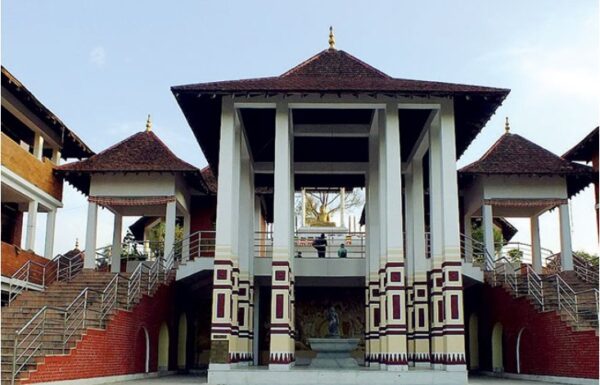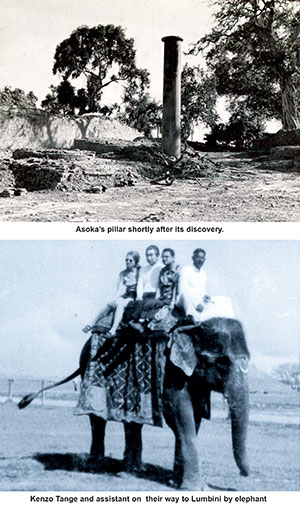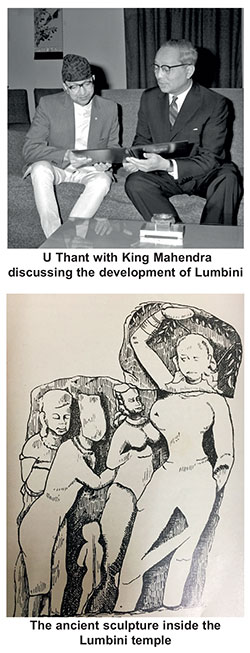Lumbini – Birth and Rebirth-by Bhante Dhammika of Australia

Source:Island
As is well-known, Lumbini is the first of the four major holy places in Buddhism, it being the place where the person who was to become the Buddha was born. Almost every account of the Buddha’s life, traditional and contemporary, recounts the incidents that supposedly occurred at his conception and birth: his mother dreaming of a white elephant before or as she conceived; giving birth to him while grasping the branch of a tree; and he emerging from her right side. Some later accounts even add that Mahamaya was a virgin when she gave birth. None of these stories are mentioned in the Tipitaka.
The only discourse in the Tipitaka dealing with the Buddha’s birth is the Acchariyabbhuta Sutta which relates several wondrous events that supposedly occurred before, during and immediately after the event. However, not all the ‘wonders’ it mentions should be dismissed as fantastic exaggerations; some may have been based on fact, while others may have had a didactic purpose.

For example, the discourse claims that Mahamaya gave birth while standing, which is by no means improbable. Little is known of ancient Indian birthing practices, but it appears that women commonly delivered in either a sitting, lateral or upright position. Interestingly, Britain’s Royal College of Midwives recommends upright birthing and says that it is quite safe if the midwife and other attendants are properly trained and prepared for it.
The discourse also says that a brilliant light appeared when the Buddha was born – not a star indicating a particular location as with the Christian nativity story – but one which allowed beings to think differently about each other. The sutta says: “When the Buddha came forth from his mother’s womb, a great immeasurable light more radiant even than the light of the gods shone forth into the world… And even in the dark, gloomy spaces between the worlds where the light of our moon and sun, powerful and majestic though they are, cannot reach, even there did that light shine.
“And the beings that are reborn in that darkness became aware of each other because of that light and thought, ‘Indeed there are other beings here’.” It would seem that this story was not meant to suggest that an actual light appeared when the Buddha was born. Rather, it is a literary device, an allegory, a way of saying that the advent of the Buddha would enable beings to become aware of each other, thus making empathy and understanding between them more likely.
Almost the only thing that can be said with certainty about the Buddha’s birth is that it took place in Lumbini, a place between the Buddha’s hometown and the main Koliyan town – Kapilavatthu and Devadaha. The birth is always depicted as happening in the open, with Mahamaya standing and grasping the branch of a tree, and although tradition says Lumbini was a garden, the Tipitaka says it was a village (gama) and King Asoka’s Lumbini inscription calls it a village too. So it is much more likely that she gave birth in one of the village houses or at least under some type of shelter.
The Buddha asked his disciples to try visit the places where the four pivotal events in his life occurred, one of these being Lumbini, and pilgrims must have started going there perhaps even while the Buddha was still alive. The first person we know of to have gone there was King Asoka who made a pilgrimage in 249 BCE. After that we have no records of Lumbini until the Chinese pilgrim Faxian went there at the beginning of the 4th century CE.
About two centuries later another Chinese pilgrim, Xuanzang, visited but neither he or Faxian gave much information about Lumbini other than to mention a few landmarks and to say that it was a rather forlorn place. It seems that by the Muslim conquest of India in the 13th century Lumbini was already lost in the jungle, it’s very whereabouts forgotten. Nothing is known at all about it for the next 1,000 years until the second half of the 19th century. Buddhists still knew of Lumbini’s significance in their religion but it seems they made no effort to locate it, an endeavor task that was taken up by westerners.
As a knowledge of Buddhism by westerns and particularly by British scholars grew, so did an interest in the religion’s historical geography – an interest which grew into a passion and a passion that became a race, to discover the places associated with the Buddha, particularly where he was born and his hometown.
Initially, where the Buddha attained awakening (Bodh Gaya) and where he proclaimed the Dhamma for the first time (Sarnath) were identified with little trouble, then one by one, Kosambi, Savatthi, Rajagaha, Visali and Kusinara were located and excavated, but Lumbini and Kapilavatthu remained frustratingly evasive. The ancient texts all said these two places were near each other so scholars knew that if they found one they would be able to find the other.
The Chinese pilgrims had left fairly detailed information about in what direction and how far one was from the other and scholars argued with each other, sometimes with a great deal of bile, where Lumbini might be found. The more intrepid of those involved in the search even hacked their way through the jungle risking malaria and tigers in a determined effort to be the first to find either place.
Eventually, some of the more perceptive scholars thought the two places might lie somewhere across the British-Indian border in Nepal, in what was called the tarai. This sparsely populated and thickly forested strip of land ran along the India-Nepal border and was dangerously malarial and deliberately left like that by the Nepal’s government in order to deter unwanted foreigners entering the kingdom.
Nonetheless, a few British officers – Vincent Smith, Laurence Waddell and Alois Fuhrer had got managed to get permission to explore parts of the tarai through the good offices of the British authorities. Fuhrer claimed to have discovered several antiquities in the area but all of them were shown to be fraudulent.
Interestingly, on several occasions the British went remarkably close to locating Lumbini without knowing it. In 1816 their surveyors demarcated the India-Nepal border in such a way that Lumbini ended up being in Nepal a mere seven km north of Indian territory. As a result, today one often reads or hears the ridiculous claim that “the Buddha was Nepalese.” If the surveyors had explored the jungle a bit more they might have stumbled on King Asoka’s great pillar and perhaps put the border slightly to its north, and Lumbini would have been in India.
A little more than 60 years later they missed another chance. In 1880, Laurence Waddell, a doctor and passionate amateur antiquarian with a particular interest in locating the Buddha’s birthplace, had been posted to a district abutting the Nepalese border and some locals had informed him that there was a stone pillar in the jungle just across the border in Nepal.
Intrigued, he instructed one of his Indian workers to go there and make a copy of any inscription that might be on the pillar, which was done. However, the worker made a copy of a small piece of graffiti near the top of the pillar – Asoka’s now famous inscription being covered by centuries of rubbish and rubble at the time. When Waddell read the graffiti, which was of no significance, he gave the pillar no further thought, and thus missed having the honor of discovering Lumbini. In the end, that honor went to a Nepalese rather than a Briton.
A Nepalese nobleman named Khadga Shumsher (1861-1921) happened to be the governor of the province which included Lumbini at this time and he came to know about British interest in finding the Buddha’s birthplace. When he heard about the pillar he went to see it, dug away some of the earth around its base and revealed Asoka’s inscription. To cut a long and rather complicated story short, British scholars heard of Shumsher’s discovery, the Nepalese gave them permission to make a copy of the inscription, it was translated and the words “for here the Lord was born” (hida Bhagavam jate ti) finally confirmed the location of Lumbini.

Newspapers in India, Germany, Britain and even Russia all reported the news. Over the next 18 months at the request of the British Indian government the Nepalese gave permission for scholars to visit Lumbini, including some of the big names in Indian and Buddhist studies, including Prof. Rhys David, Vincent Smith, L Waddell, and Willium Hoey.
Right next to Asoka’s pillar was a small temple to a goddess called by the locals Rupam Devi, the interior of which some of these visitors tried to examine, but not being Hindus the presiding swami would not let them enter. However, Hoey managed to slip into the temple unnoticed and found that its principle image was actually an ancient much worn and damaged image of the Buddha’s birth.
Realizing the importance of Lumbini’s identification, in 1899 the British authorities managed to get permission from the Nepalese government to allow
an archaeologist to come to Lumbini to do some excavations. Thinking that a Hindu would be more acceptable to the Nepalese they chose P. C. Mukherji although he was given only two months in which to do his exploration. Of many important discoveries Mukherji found was the missing part of the nativity image in Lumbini’s temple.
One would have hoped that the discovery of Lumbini would allow pilgrims to once again go there in keeping with the Buddha’s instructions that it would be uplifting for a devotee’s faith it they did so. But it was not to be. Nepal’s oppressive and reactionary Rana government was determined to prevent any outside influence into the kingdom, fearing, probably correctly, that it would endanger their grip on power.
Thus for the next 50 years it was almost impossible to visit Lumbini despite being only a few km from Indian territory. Despite such hinderances a few people, sometimes in disguise, managed to do so. A trickle of Indian, Burmese and Sri Lankan Buddhists were able to get to Lumbini, mainly because the border guards thought they might be Nepalese. A few Europeans managed to do it also.
For example, in 1933 the German Indologist Ernst Wald Schmidt teamed up with a small group of locals and accompanied them all the way to what he called “the Bethlehem of Buddhism.” But as soon as he got there a guard noticed him and demanded he leave, although they did allow him to have a look around before being accompanied back to the border.
In 1951 Nepal’s Rana regime was finally overthrown, the king, who had been confined to his palace for decades was freed, and the first attempt to establish a modern democracy in the country was made. In 1955 Indian prime minister Jawaharlal Nehru wrote to the king of Nepal informing him that the coming year would mark the 2500 anniversary of the Buddha’s birth which was expected to be celebrated around the world and suggested that he develop Lumbini for the numerous pilgrims who were expected to visit the Buddhist holy places.
King Mahendra took the hint and with a development plan provided by the Indians, a reasonably good road was constructed from Lumbini to Nautanwa (which was to become the main India-Nepal border crossing), a tourist bungalow, post office and a small Theravadin vihara were built and a tube well was dug, all paid for by the king – 100,000 rupees all told. Further, he had a forest of sal trees planted a modest garden laid out and banned animal sacrificed being made in the temple, something he could do as many Nepalese believed, an incarnation of Vishnu.
On the big day of the 1956 Buddha Jayanti the king actually visited Lumbini and announced that from that day onwards that Vesak would be a public holiday.
It should also be noted that beginning in the 1930s but especially after 1951, the Newari Buddhists of Kathmandu, many of who had converted from Mahayana to Theravada, did much to help develop Lumbini: leading pilgrim parties, looking after pilgrims who came, petitioning the governments concerning problems at Lumbini, etc., chief among being Ven. Dhammaloka and Ven. Aniruddha, an alumni of Sri Lanka’s Vidyalankara Pirivana.
When, in 1967, the deeply religious Buddhist Secretary-General of the United Nations, U Thant, visited Nepal he flew from Kathmandu to Lumbini and after his visit commented: “This is the most important day of my life” and then broke into tears.
On his return to Kathmandu, he met King Mahendra and discussed with him the possibility of further enhancing Lumbini’s sanctity. On his return to New York, he set up a UN committee to turn the nativity site into an international center for peace, got UNESCO involved who in turn hired the famous Japanese architect to draw up a master plan. Tange visited Lumbini and spent some time studing Buddhism and its history (he was not at all religious), and in 1978 his firm submitted its design.
The project to preserve Lumbini and landscape the sacred garden and surrounding park was supposed to be finished by1985, but bureaucratic indolence and corruption in Nepal slowed progress and in 2005 without ever seeing the completion of his master plan. Despite these and other setbacks, Tange’s master plan is largely finished and with most Buddhists countries and several bigger Buddhist organizations building temples there, Lumina has been reborn.







